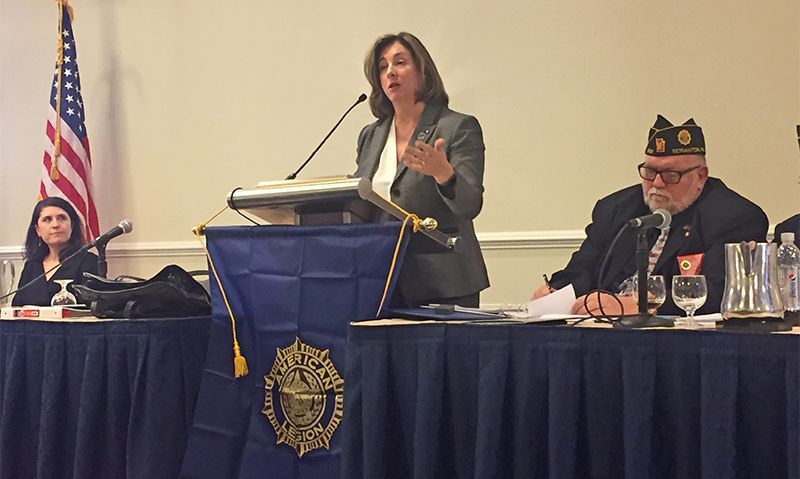
The Appeals Modernization Act offers veterans three lanes to choose from and Board of Veterans Appeals chairman shares what each one is best for.
It was on The American Legion national convention stage in Reno, Nev., in August 2017 that President Trump signed legislation to help fix the beleaguered VA appeals process.
The Veterans Appeals Improvement and Modernization Act of 2017 created three appeals lanes that veterans can choose from to help give them “choice and control. We worked with (The American Legion), our stakeholders, and we worked with other stakeholders to ensure that we built in choice and control so veterans would no longer be stuck in the process and have nowhere to go,” said Cheryl Mason, chairman of Board of Veterans Appeals (BVA), to members of The American Legion’s Veterans Affairs & Rehabilitation Commission members Feb. 25, during the organization’s annual Washington Conference in Washington, D.C.
The three lanes under the new appeals modernization process are higher-level review, supplemental claim and hearing with BVA. Mason said the big question is which lane do we help the veteran choose.
Higher-level review: If a veteran got an unsatisfactory decision back on their claim and they want an adjudicator to review it. The veteran can share what errors they saw in the original decision. The case will be decided in approximately 125 days, Mason said.
Supplemental claim: The veteran can submit or identify new and relevant evidence to support their claim. Decision on a case is approximately 125 days as well.
Hearing lane with BVA: This is when a veteran wants the board to look at the case or they want to tell their stories in person. Additional evidence can be submitted at the hearing or within 90 days. This decision takes longer, 365 days on average, Mason said.
“The reason it’s going to take the longest is because in March of 2016 when we did the appeals summit, one of the questions (our stakeholders) asked the VA is please keep the promise to the legacy veterans to do those cases. And we made that promise. That promise is the legacy cases have priority,” Mason said.
Mason said there are currently 67,000 hearing requests in the legacy appeals with only 98 judges. She asked the VA&R Commission members that if they have a veteran that has requested a hearing, please make sure they still want one. The reason for this is that last year 16,423 hearings were held; however, 24,045 were scheduled – over 8,000 veterans either postponed, rescheduled or didn’t show up.
“That’s where we need your help. We need to get those veterans to hearings,” Mason said. “We understand that it’s hard for the veterans to get to the regional offices, and to the VHA facilities that we’re partnering with to hold those hearings. We’re working on some new technology that I think will help with that so stay tuned.”
The BVA also is trying to hold more hearings by using retired veterans law judges to hold hearings to reduce the number of those pending.
If a veteran wants to change lanes, they have one year to do so from the date of the decision. Or a veteran has 60 days from the day they submitted the BVA appeal. If a veteran changes lanes, their place in line will be saved. Veterans often ask if they can get out of the board and go back to the claims agency. Mason said this can be done as long as the veteran tells the BVA in writing that they want to withdraw their appeal and then they’ll have to file with the claims agency which lane they want to be in.
“Again, veterans have a choice. They have a choice about what they want to do,” Mason said.
BVA has been surveying veterans about the three lanes and what they have found is that once veterans get to the hearings they are pleased most of the time. Areas of concern was that veterans didn’t know what to expect at the hearing or what they should bring. BVA is working with the hearing team on letters of communication with the veterans to make sure “we are telling the veteran everything they need to know before the hearing, as well as what will happen at the hearing,” Mason said.
Mason shared that the BVA hit a record last year on claims decisions – 85,288. “We are very proud of that,” she said. Veterans can find out the status of their appeal or claim by going to www.va.gov and visiting the appeals status tracker. Meanwhile, the BVA is going to break the record this year as they are on schedule to make decisions on 90,000 claims; 35,000 decisions have already been fulfilled.
"We are helping employees of the board understand what it means to serve veterans and what veterans have done for us," Mason said. "You will start to see the hashtag #Mission:Veterans. It's an internal mission that we're focused on, and we can really rally around that."
- Veterans Benefits

